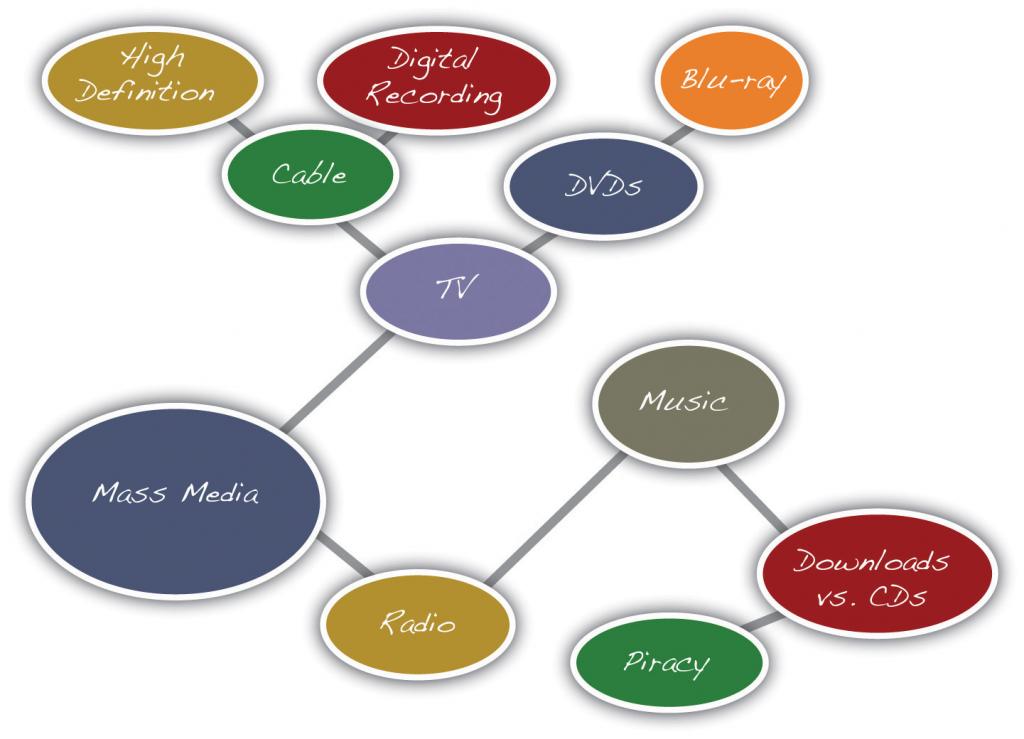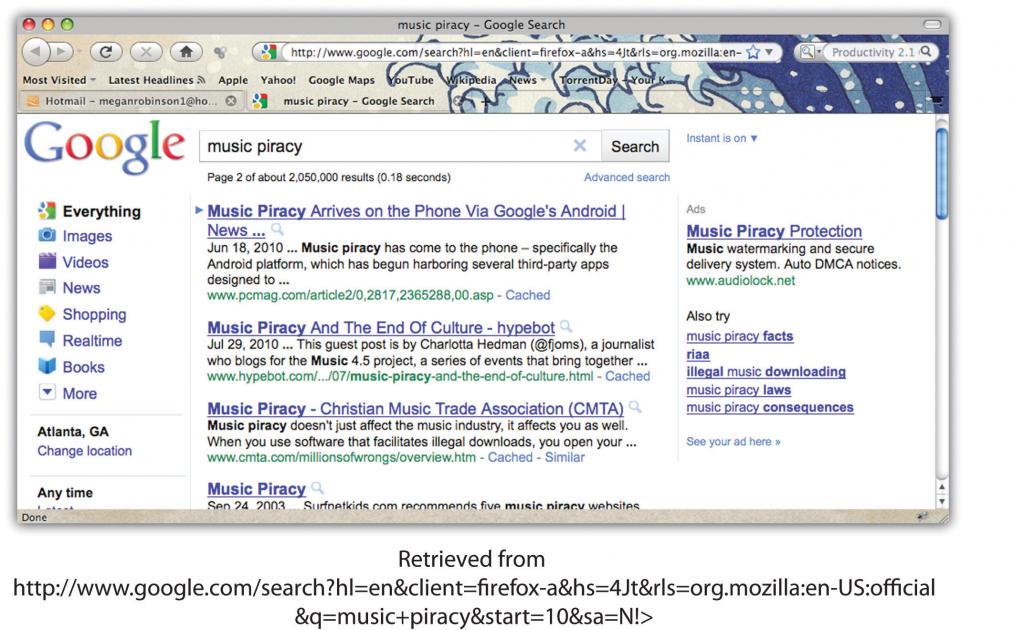Apply Prewriting Models
Prewriting is the stage of the writing process during which you transfer your abstract thoughts into more concrete ideas in ink on paper (or in type on a computer screen). Although prewriting techniques can be helpful in all stages of the writing process, the following four strategies are best used when initially deciding on a topic:
- Using experience and observations
- Reading
- Freewriting
- Asking questions
At this stage in the writing process, it is OK if you choose a general topic. Later you will learn more prewriting strategies that will narrow the focus of the topic.
Choosing a Topic
In addition to understanding that writing is a process, writers also understand that choosing a good general topic for an assignment is an essential step. Sometimes your instructor will give you an idea to begin an assignment, and other times your instructor will ask you to come up with a topic on your own. A good topic not only covers what an assignment will be about but also fits the assignment’s purpose and its audience.
In this chapter, you will follow a writer named Mariah as she prepares a piece of writing. You will also be planning one of your own. The first important step is for you to tell yourself why you are writing (to inform, to explain, or some other purpose) and for whom you are writing. Write your purpose and your audience on your own sheet of paper, and keep the paper close by as you read and complete exercises in this chapter.
My purpose:
My audience:
Using Experience and Observations
When selecting a topic, you may also want to consider something that interests you or something based on your own life and personal experiences. Even everyday observations can lead to interesting topics. After writers think about their experiences and observations, they often take notes on paper to better develop their thoughts. These notes help writers discover what they have to say about their topic.
Tip
Have you seen an attention-grabbing story on your local news channel? Many current issues appear on television, in magazines, and on the Internet. These can all provide inspiration for your writing.
Reading
Reading plays a vital role in all the stages of the writing process, but it first figures in the development of ideas and topics. Different kinds of documents can help you choose a topic and also develop that topic. For example, a magazine advertising the latest research on the threat of global warming may catch your eye in the supermarket. This cover may interest you, and you may consider global warming as a topic. Or maybe a novel’s courtroom drama sparks your curiosity of a particular lawsuit or legal controversy.
After you choose a topic, critical reading is essential to the development of a topic. While reading almost any document, you evaluate the author’s point of view by thinking about their main idea and their support. When you judge the author’s argument, you discover more about not only the author’s opinion but also your own.
Tip
The steps in the writing process may seem time consuming at first, but following these steps will save you time in the future. The more you plan in the beginning by reading and using prewriting strategies, the less time you may spend writing and editing later because your ideas will develop more swiftly.
Prewriting strategies depend on your critical reading skills. Reading prewriting exercises (and outlines and drafts later in the writing process) will further develop your topic and ideas. As you continue to follow the writing process, you will see how Mariah uses critical reading skills to assess her own prewriting exercises.
Freewriting
Freewriting is an exercise in which you write freely about any topic for a set amount of time (usually three to five minutes). During the time limit, you may jot down any thoughts that come to your mind. Try not to worry about grammar, spelling, or punctuation. Instead, write as quickly as you can without stopping. If you get stuck, just copy the same word or phrase over and over until you come up with a new thought.
Quickly recording your thoughts on paper will help you discover what you have to say about a topic. When writing quickly, try not to doubt or question your ideas. Allow yourself to write freely and unselfconsciously. Once you start writing with few limitations, you may find you have more to say than you first realized. Freewriting may even lead you to discover another topic that excites you even more.
Look at Mariah’s example. The instructor allowed the members of the class to choose their own topics, and Mariah thought about her experiences as a communications major. She used this freewriting exercise to help her generate more concrete ideas from her own experience.
Watch It: Freewriting
Watch Freewriting (2 minutes) on YouTube
Check Your Understanding: Freewriting
Asking Questions
Who? What? Where? When? Why? How? In everyday situations, you pose these kinds of questions to get more information. Who will be my partner for the project? When is the next meeting? Why is my car making that odd noise?
You seek the answers to these questions to gain knowledge, to better understand your daily experiences, and to plan for the future. Asking these types of questions will also help you with the writing process. As you choose your topic, answering these questions can help you revisit the ideas you already have and generate new ways to think about your topic. You may also discover aspects of the topic that are unfamiliar to you and that you would like to learn more about. All these idea-gathering techniques will help you plan for future work on your assignment.
When Mariah reread her freewriting notes, she found she had rambled and her thoughts were disjointed. She realized that the topic that interested her most was the one she started with: the media. She then decided to explore that topic by asking herself questions about it. Her purpose was to refine media into a topic she felt comfortable writing about. To see how asking questions can help you choose a topic, take a look at the following chart that Mariah completed to record her questions and answers. She asked herself the questions that reporters and journalists use to gather information for their stories. The questions are often called the 5WH questions, after their initial letters.
| Questions | Answers |
|---|---|
| Who? | I use media. Students, teachers, parents, employers and employees—almost everyone uses media. |
| What? | The media can be a lot of things. Television, radio, email (I think), newspapers, magazines, books. |
| Where? | The media is almost everywhere now. It’s in homes, at work, in cars, even on cell phones! |
| When? | Media has been around for a long time, but seems a lot more important now. |
| When? | Hmm. This is a good question. I don’t know why there is mass media. Maybe we have it because we have the technology now. Or people live far away from their families and they have to stay in touch. |
| How? | Well, media is possible because of the technology inventions, but I don’t know how they all work! |
Tip
Prewriting is very purpose driven; it does not follow a set of hard-and-fast rules. The purpose of prewriting is to find and explore ideas so that you will be prepared to write. A prewriting technique like asking questions can help you both find a topic and explore it. Freewriting may not seem to fit your thinking process, but keep an open mind. It may work better than you think. Perhaps brainstorming a list of topics might fit your personal style. Mariah found freewriting and asking questions to be fruitful strategies to use. In your own prewriting, use the 5WH questions in any way that benefits your planning.
Check Your Understanding: Answering the 5WH questions
Choose a general topic idea from the prewriting you completed in “Exercise 1” of this chapter. Then read each question and use your own paper to answer the 5WH questions. As with Mariah when she explored her writing topic for more detail, it is OK if you do not know all the answers. If you do not know an answer, use your own opinion to speculate, or guess. You may also use factual information from books or articles you previously read on your topic. Later in the chapter, you will read about additional ways (like searching the Internet) to answer your questions and explore your guesses.
5WH Questions
- Who?
- What?
- Where?
- When?
- Why?
- How?
Watch It: Choosing a Research Topic
Watch Tutorial: Choosing a research paper topic (4 mins) on YouTube
Video source: umnLibraries. (2018, February 19). Tutorial: Choosing a research paper topic [Video]. YouTube. https://youtu.be/ZiF34aNdkzM
Now that you have completed some of the prewriting exercises, you may feel less anxious about starting a paper from scratch. With some ideas down on paper (or saved on a computer), writers are often more comfortable continuing the writing process. After identifying a good general topic, you, too, are ready to continue the process.
Tip
You may find that you need to adjust your topic as you move through the writing stages (and as you complete the exercises in this chapter). If the topic you have chosen is not working, you can repeat the prewriting activities until you find a better one.
More Prewriting Techniques
The prewriting techniques of freewriting and asking questions helped Mariah think more about her topic, but the following prewriting strategies can help her (and you) narrow the focus of the topic:
- Brainstorming
- Idea mapping
- Searching the Internet
Narrowing the Focus
Narrowing the focus means breaking up the topic into subtopics, or more specific points. Generating lots of subtopics will help you eventually select the ones that fit the assignment and appeal to you and your audience.
After rereading her syllabus, Mariah realized her general topic, mass media, is too broad for her class’s short paper requirement. Three pages are not enough to cover all the concerns in mass media today. Mariah also realized that although her readers are other communications majors who are interested in the topic, they may want to read a paper about a particular issue in mass media.
Brainstorming
Brainstorming is similar to list making. You can make a list on your own or in a group with your classmates. Start with a blank sheet of paper (or a blank computer document) and write your general topic across the top. Underneath your topic, make a list of more specific ideas. Think of your general topic as a broad category and the list items as things that fit in that category. Often you will find that one item can lead to the next, creating a flow of ideas that can help you narrow your focus to a more specific paper topic.
The following is Mariah’s brainstorming list:
Mass media
- Magazines
- Newspapers
- Broadcasting
- Radio
- Television
- DVD
- Gaming/video games
- Internet
- Cell phones
- Smart phones
- Text messages
- Tiny cameras
- GPS
From this list, Mariah could narrow her focus to a particular technology under the broad category of mass media.
Idea Mapping
Idea mapping allows you to visualize your ideas on paper using circles, lines, and arrows. This technique is also known as clustering because ideas are broken down and clustered, or grouped together. Many writers like this method because the shapes show how the ideas relate or connect, and writers can find a focused topic from the connections mapped. Using idea mapping, you might discover interesting connections between topics that you had not thought of before.
To create an idea map, start with your general topic in a circle in the center of a blank sheet of paper. Then write specific ideas around it and use lines or arrows to connect them together. Add and cluster as many ideas as you can think of.
In addition to brainstorming, Mariah tried idea mapping. Review the following idea map that Mariah created:

Notice Mariah’s largest circle contains her general topic, mass media. Then, the general topic branches into two subtopics written in two smaller circles: television and radio. The subtopic television branches into even more specific topics: cable and DVDs. From there, Mariah drew more circles and wrote more specific ideas: high definition and digital recording from cable and Blu-ray from DVDs. The radio topic led Mariah to draw connections between music, downloads versus CDs, and, finally, piracy.
From this idea map, Mariah saw she could consider narrowing the focus of her mass media topic to the more specific topic of music piracy.
Watch It: Brainstorming and Prewriting
Watch Brainstorming and prewriting (3:32 minutes) on YouTube
Video source: Kingsborough Learning Center. (2022, February 9). Brainstorming and prewriting [Video]. YouTube. https://youtu.be/isznFoDh3eg
Searching the Internet
Using search engines on the internet is a good way to see what kinds of websites are available on your topic. Writers use search engines not only to understand more about the topic’s specific issues but also to get better acquainted with their audience.
When you search the internet, type some key words from your broad topic or words from your narrowed focus into your browser’s search engine (many good general and specialized search engines are available for you to try). Then look over the results for relevant and interesting articles.
Results from an internet search show writers the following information:
- Who is talking about the topic
- How the topic is being discussed
- What specific points are currently being discussed about the topic
Tip
If the search engine results are not what you are looking for, revise your key words and search again. Some search engines also offer suggestions for related searches that may give you better results.
Mariah typed the words music piracy from her idea map into Google.

Not all the results online search engines return will be useful or reliable. Give careful consideration to the reliability of an online source before selecting a topic based on it. Remember that factual information can be verified in other sources, both online and in print.
The results from Mariah’s search included websites from university publications, personal blogs, online news sources, and lots of legal cases sponsored by the recording industry. Reading legal jargon made Mariah uncomfortable with the results, so she decided to look further. Reviewing her map, she realized that she was more interested in consumer aspects of mass media, so she refocused her search to media technology and the sometimes confusing array of expensive products that fill electronics stores. Now, Mariah considers a paper topic on the products that have fed the mass media boom in everyday lives.
Check Your Understanding: Prewriting
Prewriting strategies are a vital first step in the writing process. First, they help you first choose a broad topic and then they help you narrow the focus of the topic to a more specific idea. An effective topic ensures that you are ready for the next step.
Topic Checklist—Developing a Good Topic
The following checklist can help you decide if your narrowed topic is a good topic for your assignment:
- Am I interested in this topic?
- Would my audience be interested?
- Do I have prior knowledge or experience with this topic? If so, would I be comfortable exploring this topic and sharing my experiences?
- Do I want to learn more about this topic?
- Is this topic specific?
- Does it fit the length of the assignment?
With your narrowed focus in mind, answer the bulleted questions in the checklist for developing a good topic. If you can answer “yes” to all the questions, write your topic on the line. If you answer “no” to any of the questions, think about another topic or adjust the one you have and try the prewriting strategies again.
Attribution & References
Except where otherwise noted, this section is adapted from “3.2 – Apply Prewriting Models” In Communication Essentials for College by Emily Cramer & Amanda Quibell, licensed under CC BY-NC 4.0. An adaptation from “8.1 Apply Prewriting Models” In Writing for Success by University of Minnesota licensed under CC BY-NC 4.0. / Adaptations: Additional accessibility features have been added to original content. Alterations include renaming exercises as learning activities and added brainstorming and prewriting video.



